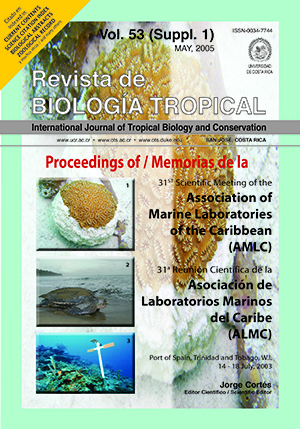Abstract
The spatial distribution of seagrass and algae communities can be difficult to determine in large, shallow lagoon systems where high turbidity prevents the use of optical methods like aerial photography or satellite imagery. Further complications can arise when algae are not permanently attached to the substratum and drift with tides and currents. A study using acoustic seafloor discrimination was conducted in the Indian River Lagoon (Florida, USA) to determine the extent of drift algae and seagrass. Acoustic surveys using the QTC View V system based on 50 and 200 kHz transducers were conducted near Sebastian Inlet. Results indicate that areas of seagrass can be identified, and are mixed with a high abundance of drift algae. Nearest-neighbor extrapolation was used to fill in spaces between survey lines and thus obtain spatially cohesive maps. These maps were then ground-truthed using data from towed video and compared using confusion matrices. The maps showed a high level of agreement (60%) with the actual distribution of algae, however some confusion existed between bare sand and algae as well as seagrass.References
Anonymous. 2000. QTC Impact User Manual. Quester Tangent Corporation, Canada. 110 p.
Bates, C.R. & E.J. Whitehead. 2001. Echoplus measurements in Hopavagen Bay, Norway. Sea Technol. 42: 34-43.
Chivers, R.C., N. Emerson & D.R. Burns. 1990. New acoustic processing for underway surveying. Hydrographic J. 56: 9-19.
Collins, W.T. & P. Lacroix. 1997. Operational philosophy of acoustic waveform data processing for seabed classification. COSU 97, Oceanology International, Singapore 97: 225-234.
Collins, W.T., R. Gregory & J. Anderson. 1996. A digital approach to seabed classification. Sea Technol. 37: 83-87.
Green, E.P., P.J. Mumby, A.J. Edwards & C.D. Clark. 2000. Remote sensing handbook for tropical coastal management. Coastal Management Sourcebooks 3, UNESCO Paris. 316 p.
Hamilton, L.J. 2001. Acoustic seabed classification systems. Department of Defence, Defence Science and Technology Organization (Australia). 150 p.
Hamilton, L.J., P.J. Mulhearn & R. Poeckert. 1999. Comparison of RoxAnn and QTC-View acoustic bottom classification system performance for the Cairns area, Great Barrier Reef, Australia. Cont. Shelf Res. 19: 1577-1597.
Lawrence, M.J. & C.R. Bates. 2001. Acoustic ground discrimination techniques for submerged archaeological site investigations. MTS Journal 35: 65-73.
Legendre, P. 2002. Acoustic seabed classification methodology: a user’s statistical comparison. Departement de Sciences Biologiques, Universite de Montreal. 17 p.
Legendre, P., K.E. Ellingsen, E. Bjornbom & P. Casgrain. 2002. Acoustic seabed classification: improved statistical methods. Can. J. Fish. Aquat. Sci. 59: 1085-1089.
Morris, L.J. & L.M. Hall. 2001. Estimating drift algae abundance in the Indian River Lagoon, FL. St. Johns River Water Management District Tech. Memo. 10 p.
Morris, L.J., R.W. Virnstein, J.D. Miller & L.M. Hall. 2000. Monitoring changes in Indian River Lagoon, Florida, using fixed transects, p. 167-176. In S.A. Bortone (ed.). Seagrass Monitoring, Ecology, Physiology and Management. CRC Press, Boca Raton.
Morrison, M.A., S.F. Thrush & R. Budd. 2001. Detection of acoustic class boundaries in soft sediment systems using the seafloor acoustic discrimination system QTC VIEW. J. Sea Res. 46: 233-243.
Mumby, P.J. & E.P. Green. 2000. Field survey: building the link between image and reality, p. 57-67. In E.P. Green, P.J. Mumby, A.J. Edwards & C.D. Clark (eds.). Remote Sensing Handbook for Tropical Coastal Management. Coastal Management Sourcebooks 3, UNESCO, Paris.
Prager, B.T., D.A. Caughey & R.H. Poeckert. 1995. Bottom classification: operational results from QTC View. Oceans ’95, San Diego, October 1995. Pp. 1827-1835.
Preston, J.M., A. Rosenberger & W.T. Collins. 2000. Bottom classification in very shallow water. Proc. Oceans 2000, Newport. Pp. 1563-1567.
Preston, J.M., W.T. Collins, D.C. Mosher, R.H. Poeckert & R.H. Kuwahara. 1999. The strength of correlations between geotechnical variables and acoustic classifications. Proc. MTS/IEEE OCEANS’99 Conf., September 1999. Pp. 1123-1128.
Preston, J.M., A. Rosenberger, & W.T. Collins. 2000. Bottom classification in very shallow water. Proc. Oceans 2000, Newport:
Preston, J.M., A.C. Christney, L.S. Beran, W.T. Collins & R.A. McConnaughey. 2002. Objective measures of acoustic diversity for benthic habitat characterization. Symp. Effects Fisheries Benthic Habitats: Linking Geology, Biology, Socioeconomy and Management, Tampa 2002. Pp. 45.
Virnstein, R.W. & P.A. Carbonara. 1985. Seasonal abundance and distribution of drift algae and seagrass in the mid-Indian River Lagoon, FL. Aquat. Bot. 23: 67-82.
Virnstein, R.W. & R.K. Howard. 1987. Motile epifauna of marine macrophytes in the Indian River Lagoon, Florida. II. Comparison between drift macroalgae and three species of seagrass. Bull. Mar. Sci. 41: 13-26.
##plugins.facebook.comentarios##

This work is licensed under a Creative Commons Attribution 4.0 International License.
Copyright (c) 2005 Revista de Biología Tropical






